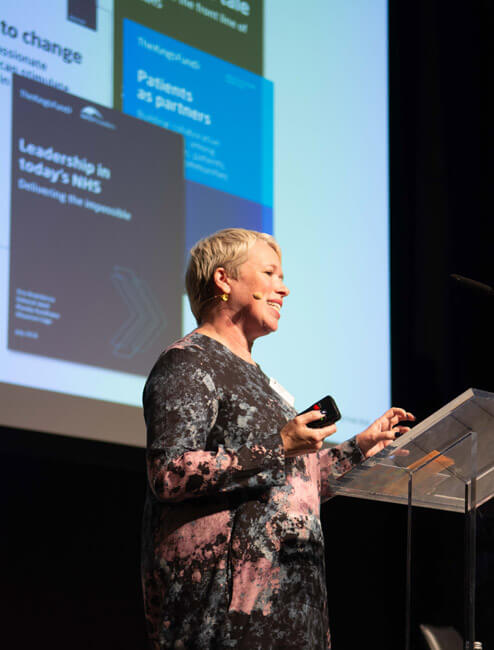Five per cent more staff working in real teams was associated with 3.3% drop in mortality rate (p= .006), which for an “average” acute hospital, represented around 40 deaths per year, Ms. Suzie Bailey, Executive Director of Leadership and Organisational Development Team, King’s Fund, told the Conference.

She was speaking on “No-one can whistle a symphony – collective leadership in action.”
Ms. Bailey said The King’s Fund was an independent charity working to improve health and care in England. “Our vision is that the best possible care is available to all. We were founded in 1897 by the Prince of Wales, who later became King Edward VII, to help London’s voluntary hospitals. Since then our work has evolved in response to the creation of the NHS and changes in health and care policy and practice.
“We help to shape policy through research and analysis, develop individuals, teams and organisations, promote understanding of the health and social care system, and bring people together to learn, share knowledge and debate.”
A national framework for action on improvement and leadership development in NHS-funded services was published by NHS Improvement in December 2016, sponsored by key national organisations with NHS responsibilities.
The national agencies involved were the Department of Health, NHS Improvement, NHS Health Education England, NHS England, Public Health England, Care Quality Commission, NHS Leadership Academy. Skillsforcare, Local Government Association, NHS providers, National Institute for Health and Care Excellence (NICE ) NHS Clinical Commissioners and NHS Confederation.
It aimed to guide local, regional and national action on developing NHS staff, to equip and encourage them to work towards improving local health and care systems, while having pride and joy in their work.
There were also difficulties when a high percentage of senior management were recent appointees.
Conditions within the framework provided for – leaders to be equipped to develop high quality local health and care systems in partnership, compassionate, inclusive and effective leaders at all levels, knowledge of improvement methods and how to use them at all levels, support systems for learning at local, regional and national levels and enablng supportive and aligned regulation and oversight.
Ms. Bailey said the inverse leadership law was that the most challenged organisations had the highest leadership churn.
The Care Quality Commission (CQC) which monitors, inspects and regulates health and social care services, had rated vacant posts and found that for an organisation, 14.3 per cent of vacant posts was inadequate, 8.8 per cent required improvement 7.7 per cent was good and 3.3 per cent was outstanding.
There were also difficulties when a high percentage of senior management were recent appointees, while years after “Snowy white peaks,” diverse leadership remained a challenge despite some recent progress.
She said leadership in the NHS had become more difficult, more complex. Leadership was also becoming more personal, which left people feel more exposed, which made them feel more vulnerable.
Ms. Bailey quoted an NHS Trust CEO, who had said,“If you go back five years, there was an era of white men of a certain age in power who were the centre of gravity and had a big influence on the type of leader who came through…there has been an unleashing of a new generation of talent that is bringing genuinely fresh thinking.”
The 2019 NHS Interim People Plan aimed to strengthen and support good, compassionate and diverse leadership at all levels. It also accepted this positive, compassionate leadership was not consistently demonstrated across the system’
Leadership was also becoming more personal, which left people feel more exposed, which made them feel more vulnerable.
Looking at Collective Leadership she said:
- “Leadership is the responsibility of all.
- “There should be shared, inclusive leadership in teams and across teams.
- “There should be interdependent, collaborative leadership – across the system/organisation.
- “There should be a consistent approach to leadership – authentic, open, curious, appreciative, compassionate.
- There should be compassionate and inclusive leadership.
There were four conditions for effective teams:
- A real team – bounded, stable, interdependent with a real team task.
- Clear team purpose, challenging & consequential with clear objectives.
- Who should be on the team – skills and roles, enablers not derailers.
- Developing through regular coaching.
Five per cent more staff working in real teams was associated with 3.3% drop in mortality rate (p= .006), which for an “average” acute hospital, represented around 40 deaths per year.
She said compassionate and inclusive leadership involved:
- Attending: paying attention to staff – ‘listening with fascination’
- Understanding: finding a shared understanding of the situation they face.
- Empathising.
- Helping: taking intelligent action to help.

